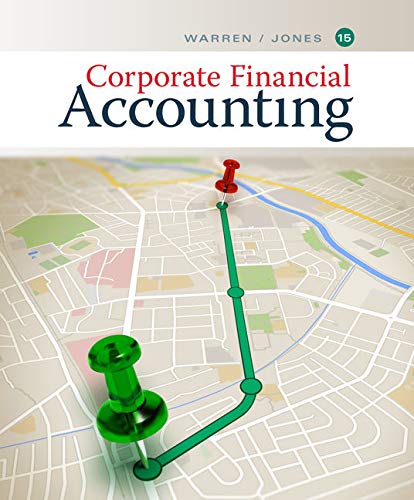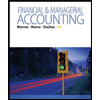
1.
To prepare:
1.
Explanation of Solution
Bonds: Bonds are long-term promissory notes that are represented by a company while borrowing money from investors to raise fund for financing the operations.
Bonds Payable: Bonds payable are referred to long-term debts of the business, issued to various lenders known as bondholders, generally in multiples of $1,000 per bond, to raise fund for financing the operations.
Premium on bonds payable: It occurs when the bonds are issued at a high price than the face value.
Prepare journal entry for cash proceeds from the issuance of the bonds on July 1, 20Y1.
| Date | Account Title and Explanation | Post Ref | Debit ($) | Credit ($) | |||
| 20Y1 | Cash | 31,951,110 | |||||
| July | 1 | Premium on Bonds Payable (1) | 1,951,110 | ||||
| Bonds Payable | 30,000,000 | ||||||
| (To record issue of bonds at premium) | |||||||
Table (1)
- Cash is an asset and it is increased. So, debit it by $31,951,110.
- Premium on Bonds Payable is an adjunct liability account and it is increased. So, credit it by $1,951,110.
- Bonds payable is a liability and it is increased. So, credit it by $30,000,000.
Working note:
Calculate premium on bonds payable.
2. a.
To prepare: Journal entry to record first semiannual interest payment and amortization of bond premium on December 31, 20Y1.
2. a.
Explanation of Solution
Bonds: Bonds are long-term promissory notes that are represented by a company while borrowing money from investors to raise fund for financing the operations.
Bonds Payable: Bonds payable are referred to long-term debts of the business, issued to various lenders known as bondholders, generally in multiples of $1,000 per bond, to raise fund for financing the operations.
Premium on bonds payable: It occurs when the bonds are issued at a high price than the face value.
Straight-line amortization method: It is a method of bond amortization that spreads the amount of the bond discount equally over the interest period.
Prepare journal entry for first semiannual interest payment and amortization of discount on bonds.
| Date | Account Title and Explanation | Post Ref | Debit ($) | Credit ($) | |||
| 20Y1 | Interest Expense (4) | 1,402,556 | |||||
| December | 31 | Premium on Bonds Payable (2) | 97,556 | ||||
| Cash (3) | 1,500,000 | ||||||
| (To record first semiannual payment of interest on bonds) | |||||||
Table (2)
- Interest expense is an expense and it decreases the equity value. So, debit it by $1,402,556.
- Premium on Bonds Payable is an adjunct liability account and it is decreased. So, debit it by $97,556.
- Cash is an asset and it is decreased. So, credit it by $1,500,000.
Working notes:
Calculate premium on bonds payable semiannually.
Calculate the amount of cash interest.
Calculate the interest expense on the bond.
b.
To prepare: Journal entry to record second interest payment and amortization of bond discount on June 30, 20Y2.
b.
Explanation of Solution
Bonds: Bonds are long-term promissory notes that are represented by a company while borrowing money from investors to raise fund for financing the operations.
Bonds Payable: Bonds payable are referred to long-term debts of the business, issued to various lenders known as bondholders, generally in multiples of $1,000 per bond, to raise fund for financing the operations.
Premium on bonds payable: It occurs when the bonds are issued at a high price than the face value.
Straight-line amortization method: It is a method of bond amortization that spreads the amount of the bond discount equally over the interest period.
Prepare journal entry for second interest payment and amortization of discount on bonds.
| Date | Account Title and Explanation | Post Ref | Debit ($) | Credit ($) | |||
| 20Y2 | Interest Expense (7) | 1,402,444 | |||||
| June | 30 | Premium on Bonds Payable (5) | 97,556 | ||||
| Cash (6) | 1,500,000 | ||||||
| (To record second semiannual payment of interest on bonds) | |||||||
Table (3)
- Interest expense is an expense and it decreases the equity value. So, debit it by $1,402,444.
- Premium on Bonds Payable is an adjunct liability account and it is decreased. So, debit it by $97,556.
- Cash is an asset and it is decreased. So, credit it by $1,500,000.
Working notes:
Calculate premium on bonds payable semiannually.
Calculate the amount of cash interest.
Calculate the interest expense on the bond.
3.
The amount of total interest expense for 20Y1.
3.
Answer to Problem 11.2APR
Explanation of Solution
Determine the amount of total interest expense for 20Y1.
4.
Bonds: Bonds are long-term promissory notes that are represented by a company while borrowing money from investors to raise fund for financing the operations.
Contract interest rate: It refers to the interest rate that is stated on the face of the bonds.
Market interest rate: It refers to the interest rate that the lenders expect, or demands from the borrower to part with their money as loan to them.
To explain: The situation when contract rate of bond is greater than the market rate of interest.
4.
Answer to Problem 11.2APR
Yes, the bond proceeds will always be greater than the face amount of bonds when the contract interest rate is greater than the market interest rate.
Explanation of Solution
If the stated interest rate of a bond is greater than the market interest rate, then the bonds is issued at premium. This is because the bonds are more valuable in market and investors are ready to pay more than the maturity
5.
To calculate: The amount of cash proceeds (present value) from the sale of the bonds using present value tables.
5.
Answer to Problem 11.2APR
Explanation of Solution
Bonds: Bonds are long-term promissory notes that are represented by a company while borrowing money from investors to raise fund for financing the operations.
Bonds Payable: Bonds payable are referred to long-term debts of the business, issued to various lenders known as bondholders, generally in multiples of $1,000 per bond, to raise fund for financing the operations.
Determine the amount of cash proceeds (present value) from the sale of the bonds.
Step 1: Calculate the semiannual interest on bonds.
Step 2: Calculate the present value of interest.
| Particulars | Amount |
| Interest payment (a) | $1,500,000 |
| PV factor at semiannual market interest rate of 4.5% for 20 periods (b) | 13.00794 |
| Present value
| $19,511,910 |
Table (4)
Note: Refer Appendix A in the text book for present value factor.
Step 3: Calculate the present value of lump sum payment of $30,000,000 (principal amount) at 4.5% for 20 periods.
| Particulars | Amount |
| Single payment (a) | $30,000,000 |
| PV factor at semiannual market interest rate of 4.5% for 20 periods (b) | 0.41464 |
| Present value
| $12,439,200 |
Table (5)
Note: Refer Appendix A in the text book for present value factor.
Step 4: Calculate the amount of cash proceeds from the sale of the bonds.
Want to see more full solutions like this?
Chapter 11 Solutions
Cengagenowv2, 1 Term Printed Access Card For Warren/jones’ Corporate Financial Accounting, 15th
- A $100,000 5-year 6% bond is issued on January 1, 2026. The bond pays interest annually. The market rate is 7%. What is the selling price of the bonds, rounded to the nearest dollar? Question 6 options: $104,213 $95,900 $100,000 $4,100arrow_forwardA $100,000 5-year 6% bond is issued on January 1, 2026. The bond pays interest annually. The market rate is 7%. What is the selling price of the bonds, rounded to the nearest dollar? Question 6 options: $104,213 $95,900 $100,000 $4,100arrow_forwardDell Industries has a normal capacity of 30,000 direct labor hours. The company's variable costs are $45,000, and its fixed costs are $27,000 when operating at normal capacity. What is its standard manufacturing overhead rate per unit?arrow_forward
- Which statement about a "treasury shares" is correct? Question 10 options: These shares continue to have voting rights. These shares must be cancelled upon re-purchase. The company does not pay dividends on these shares. These shares are disclosed as issued and outstanding.arrow_forwardWhich statement best describes the accounting when a company cancels its own shares at an amount higher than the average share value? Question 9 options: Contributed surplus and retained earnings will be debited. Contributed surplus will be debited, thereby decreasing equity. Contributed surplus and retained earnings will be credited. Contributed surplus will be credited, thereby increasing equity.arrow_forwardWhich statement is correct? Question 8 options: A corporation need only pay dividends when it declares them to be payable. A company can avoid a cumulative dividend on preferred shares if it declares dividends on common shares. Dividends are never discretionary payments. Companies must pay the shareholders interest to compensate for the time value of money lost on the deferral of dividend payments. No entryarrow_forward
- Which statement is correct about the derecognition of a matured obligation? Question 7 options: There will be a gain on retirement. There could be either a gain or loss on retirement. There will be no gain or loss on retirement. There will be a loss on retirement.arrow_forwardWhat is a bond indenture? Question 5 options: Guarantee of the price to the borrower. Promise from the borrower to restrict certain activities. Contract that outlines the terms of the borrowing agreement. Feature that permits the borrower to redeem before maturity.arrow_forwardWhich of the following would be a "non-current liability"? Question 4 options: Payment due to a supplier 45 days after year-end for supplies received before year-end. Payment due to a supplier in 18 months for goods to be received 3 months after year-end. Payment due after 3 years, on which the debt covenants have been not been violated. Payment due after 3 years, but the company has violated the debt covenants. Previous PageNext Pagearrow_forward
 College Accounting, Chapters 1-27AccountingISBN:9781337794756Author:HEINTZ, James A.Publisher:Cengage Learning,
College Accounting, Chapters 1-27AccountingISBN:9781337794756Author:HEINTZ, James A.Publisher:Cengage Learning, Excel Applications for Accounting PrinciplesAccountingISBN:9781111581565Author:Gaylord N. SmithPublisher:Cengage LearningPrinciples of Accounting Volume 1AccountingISBN:9781947172685Author:OpenStaxPublisher:OpenStax College
Excel Applications for Accounting PrinciplesAccountingISBN:9781111581565Author:Gaylord N. SmithPublisher:Cengage LearningPrinciples of Accounting Volume 1AccountingISBN:9781947172685Author:OpenStaxPublisher:OpenStax College Financial AccountingAccountingISBN:9781305088436Author:Carl Warren, Jim Reeve, Jonathan DuchacPublisher:Cengage Learning
Financial AccountingAccountingISBN:9781305088436Author:Carl Warren, Jim Reeve, Jonathan DuchacPublisher:Cengage Learning Cornerstones of Financial AccountingAccountingISBN:9781337690881Author:Jay Rich, Jeff JonesPublisher:Cengage Learning
Cornerstones of Financial AccountingAccountingISBN:9781337690881Author:Jay Rich, Jeff JonesPublisher:Cengage Learning Financial & Managerial AccountingAccountingISBN:9781285866307Author:Carl Warren, James M. Reeve, Jonathan DuchacPublisher:Cengage Learning
Financial & Managerial AccountingAccountingISBN:9781285866307Author:Carl Warren, James M. Reeve, Jonathan DuchacPublisher:Cengage Learning





